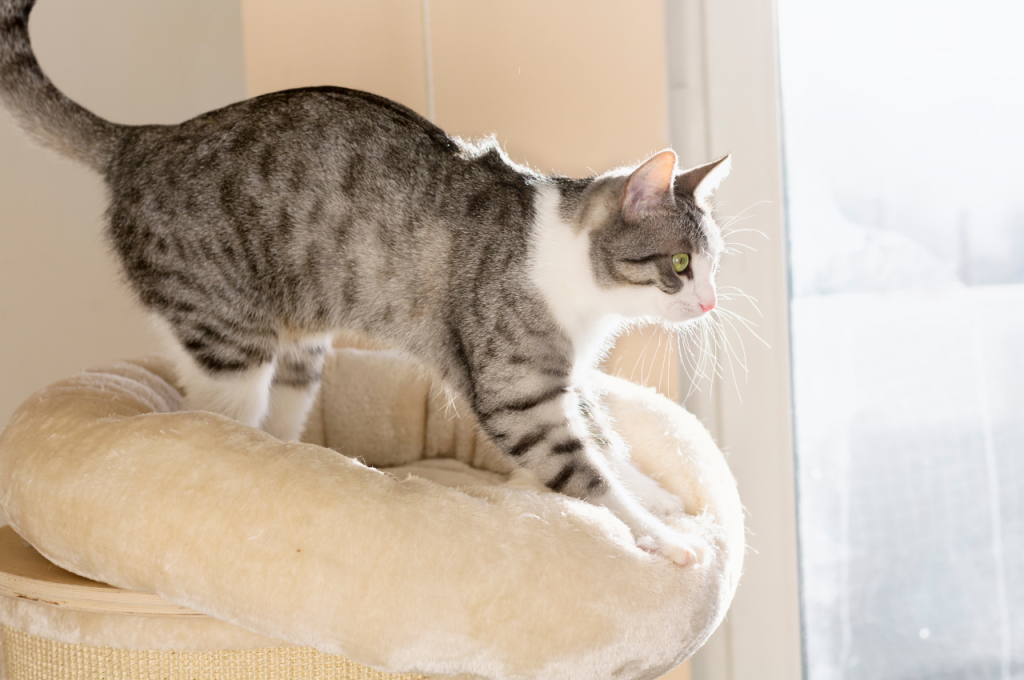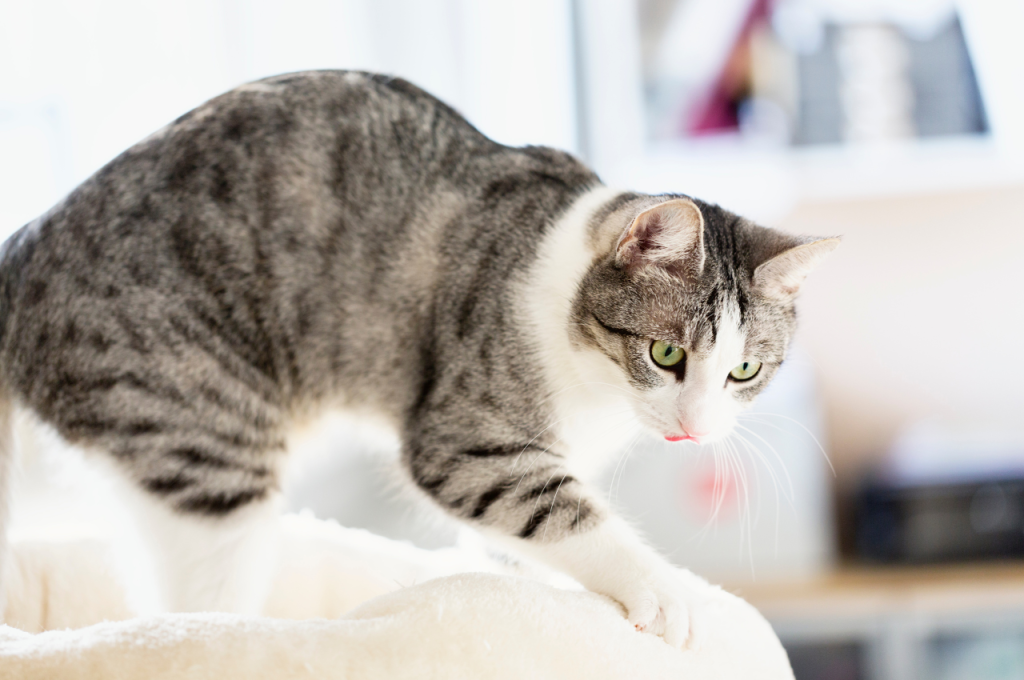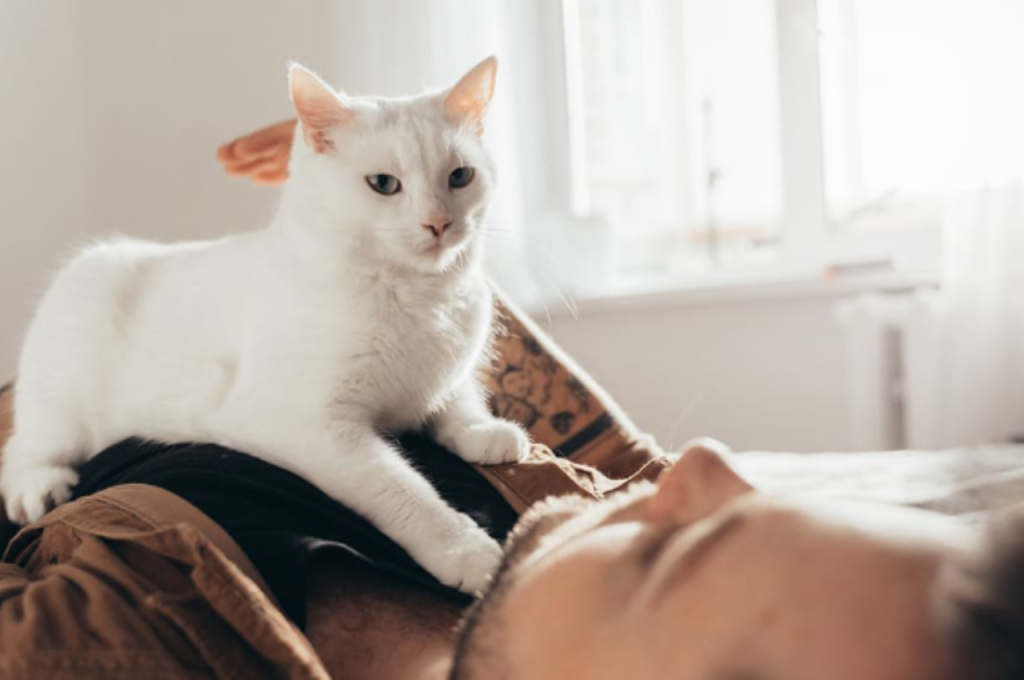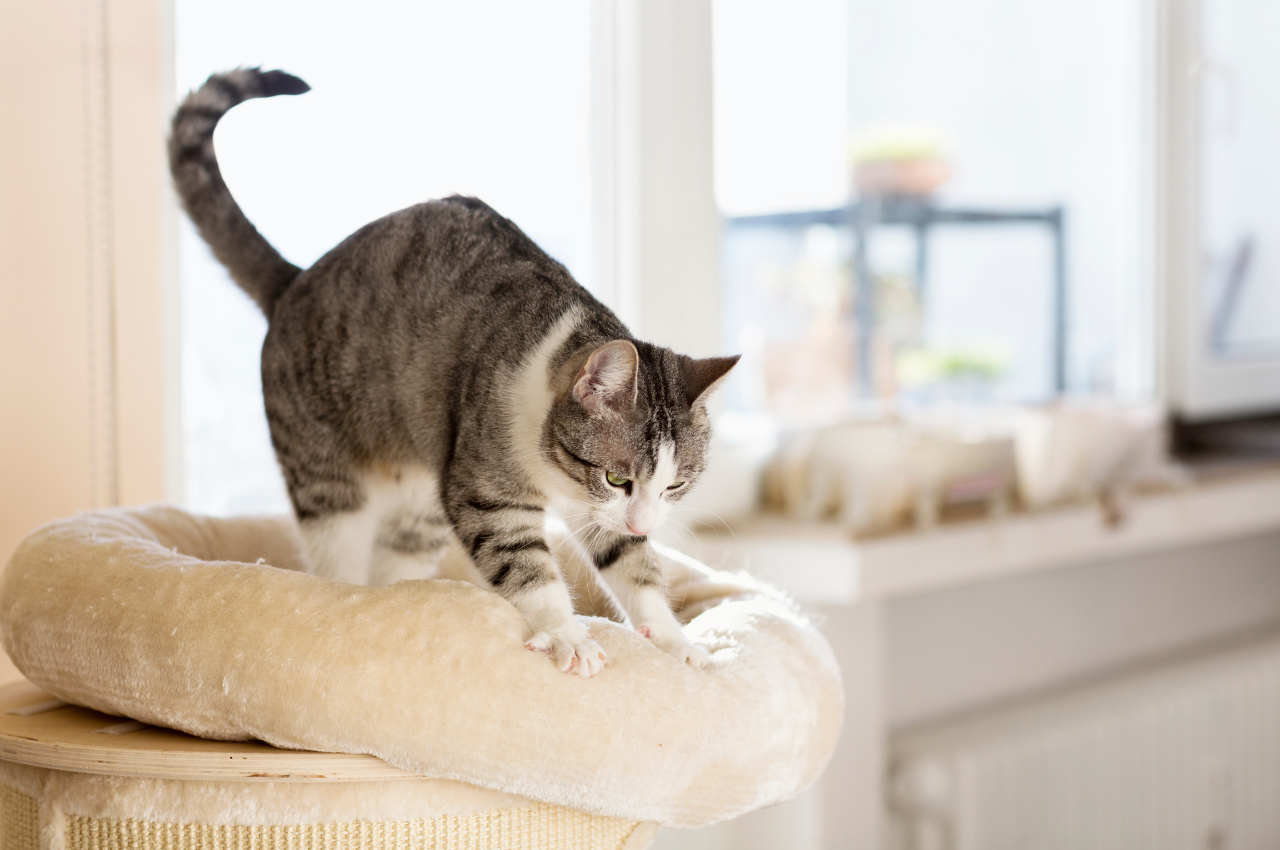Cats knead to mark territory with scent glands in their paws and show comfort. This behavior is instinctual and often linked to kittenhood.
Whether it’s on your lap, a soft blanket, or even a piece of furniture, the rhythmic motion of a cat’s paws is a common and endearing sight for many cat owners. Understanding why cats knead can provide insight into their behavior and strengthen the bond between you and your feline companion. Let’s explore the fascinating reasons behind this natural feline behavior and delve into the significance of kneading for cats and their human counterparts.
The Cozy Mystery of Kneading
Cats are known for their peculiar behaviors, and one of the most interesting ones is kneading. This activity involves cats pushing their paws in and out against a soft surface, such as a blanket or their owner’s lap. While it may seem like a simple action, there is more to kneading than meets the eye. In this post, we’ll explore the reasons behind this common feline behavior and the theories that attempt to explain it.

A Common Feline Behavior
If you’re a cat owner, chances are you’ve witnessed your furry friend kneading at some point. This behavior is more common in kittens, who knead their mother’s belly to stimulate milk production while nursing. However, many adult cats continue to knead throughout their lives, often as a sign of contentment or relaxation. Some cats even purr while kneading, which can be a soothing sound for their owners.
Theories Behind The Kneading Habit
Despite its prevalence, the exact reason why cats knead is still a mystery. However, there are several theories that attempt to explain this behavior:
| Theory | Explanation |
| Muscle Memory | Some experts believe that kneading is a leftover behavior from when cats were wild and needed to make a comfortable bed out of leaves or grass. By pushing down on the surface, they could create a soft spot to rest. |
| Marking Territory | Cats have scent glands in their paws, and kneading could be a way to mark their territory with their unique scent. |
| Showing Affection | Kneading could be a way for cats to show affection to their owners or other cats. By kneading, they release endorphins that make them feel good and can also bond with their loved ones. |
While we may never know for sure why cats knead, it’s clear that this behavior is an important part of their lives. Whether they’re kneading to show affection, mark their territory, or simply relax, it’s a fascinating and endearing habit that cat lovers can appreciate.
Tracing The Roots: Kittenhood to Adulthood
From kittenhood to adulthood, cats knead instinctively as a way to show contentment and relaxation. This behavior, reminiscent of nursing, is thought to stem from their early days when they kneaded their mother’s belly to stimulate milk flow. It’s a natural feline instinct that carries into their adult lives, often seen when they’re feeling comfortable and secure.
Kittenhood to Adulthood Cats are known for their quirky behavior, and one of the most endearing and adorable actions they do is kneading. Kneading is when cats push and pull their paws on soft surfaces, such as blankets, pillows, or even their owners’ laps. But why do cats knead? To understand this, we need to trace their roots from kittenhood to adulthood. Nursing Instincts at Play When kittens are born, they rely on their mother’s milk for survival. To get the milk flowing, kittens knead their mother’s belly, which stimulates milk production.
This action becomes a habit and instinct for kittens. Even after they are weaned, kittens continue to knead as a way of seeking comfort and security. Transition into Comfort and Affection As cats grow older, kneading becomes a way to show affection and mark their territory. Cats have scent glands in their paws, and kneading helps spread their scent on surfaces, claiming them as their own. Kneading also releases endorphins, which give cats a sense of comfort and relaxation.
In conclusion, kneading is a natural behavior for cats that starts in kittenhood and continues into adulthood. It’s a way for cats to seek comfort, show affection, and mark their territory. So the next time your furry friend starts kneading, know that it’s just their way of saying “I love you” and feeling safe and secure.
Beneath The Paws: Understanding The Sensory Experience
When it comes to our feline companions, there is so much more beneath their paws than meets the eye. Cats are known for their unique behaviors, and one of the most intriguing is kneading. This rhythmic motion, where cats push their paws in and out against a soft surface, has puzzled cat owners for years. To truly understand why cats knead, we need to delve into the sensory experience that lies beneath their paws.
Whisker Feedback
Whiskers play a crucial role in a cat’s sensory perception, acting as delicate antennae that help them navigate and explore their surroundings. These long, stiff hairs are not only located on a cat’s face but also on the backs of their front legs, just above their paws. As cats knead, their whiskers brush against the surface, providing valuable feedback. This tactile sensation adds to the overall sensory experience, enhancing their comfort and relaxation.
Paw Pressure
The pressure exerted by a cat’s paws during kneading is another important aspect of their sensory experience. As they push their paws in and out, they apply gentle pressure against the surface beneath them. This pressure stimulates the nerves in their paws, releasing endorphins and creating a pleasurable sensation. It’s similar to how a massage can relax and soothe us humans. Kneading allows cats to release tension and feel content, making it an instinctive behavior ingrained in their nature.
The Role of Scent Markers
Cats have scent glands in their paw pads, which play a significant role in their communication. As they knead, these scent glands release pheromones onto the surface they are kneading. These pheromones act as a form of marking, leaving their scent behind. This behavior is instinctual and serves multiple purposes. It helps cats establish their territory, provides a sense of familiarity, and can even serve as a form of self-soothing. So, the next time your cat kneads, remember that they are not only enjoying a sensory experience but also leaving their mark.
Emotional Connections: Kneading and Bonding
When it comes to understanding the unique behaviors of our feline friends, the act of kneading is often a source of curiosity and wonder for cat owners. The rhythmic motion of a cat pressing their paws into a soft surface, such as a blanket or their favorite human, is not only a physical act but also holds deep emotional significance. This behavior, known as kneading, is an instinctual behavior that serves as a means of emotional connection and bonding for cats.

Signs of Trust And Love
One of the primary reasons cats knead is to convey feelings of trust and affection. This rhythmic motion is often accompanied by purring, indicating that the cat is in a state of contentment and comfort. The act of kneading, which begins in kittenhood during nursing, is a comforting and soothing behavior that becomes a way for cats to express their love and bond with their human companions.
Strengthening The Human-cat Bond
The act of kneading not only signifies a cat’s emotional connection to their human but also serves to strengthen the bond between the two. When a cat kneads its owner, it is a display of trust and contentment, as they feel secure and relaxed in the presence of their beloved human. As a result, reciprocating this affection by providing a comfortable and safe environment further solidifies the bond between the cat and their owner.
Health And Well-being: The Benefits of Kneading
Understanding why cats knead goes beyond mere curiosity. This rhythmic motion is not just a feline quirk; it actually holds several benefits for their health and overall well-being.
Stress Relief for Cats
Cats knead to reduce stress and anxiety. This behavior helps them relax and feel comforted, similar to how a massage can calm humans.
Muscle Stretching and Flexibility
Kneading helps cats stretch their muscles, improving circulation and maintaining flexibility. It’s like a mini workout for their paws and shoulders.
When Kneading Becomes a Concern
Cats kneading is a natural behavior that stems from kittenhood when they knead their mother’s belly to stimulate milk flow. However, when kneading becomes excessive or accompanied by certain signs, it may be a cause for concern and require attention.
Excessive Kneading Behaviors
Excessive kneading, also known as “wool sucking” or “pica,” may involve intense and prolonged kneading sessions, often directed at soft materials such as blankets, clothing, or even human skin. This behavior can lead to ingestion of foreign objects and potential digestive issues.
- Obsessive and prolonged kneading sessions
- Ingestion of fabric or other materials
- Agitation or anxiety when prevented from kneading
Signs to Consult A Veterinarian
If you notice any of the following signs during your cat’s kneading behavior, it is advisable to consult a veterinarian:
- Bleeding or injury to the skin from excessive kneading
- Vomiting, diarrhea, or constipation due to ingested materials
- Weight loss or decreased appetite associated with compulsive kneading
Cultural Perceptions and Folklore
Throughout history, cats have held a special place in the hearts and minds of people around the world. Their enigmatic behavior, including the charming habit of kneading, has sparked a wide array of cultural perceptions and folklore. Let’s delve into the historical views on kneading and explore the myths and superstitions that have surrounded this endearing feline behavior.
Historical Views on Kneading
Kneading, also known as “making biscuits,” has been observed in domestic cats and their wild counterparts for centuries. In ancient Egypt, cats were revered as sacred animals, and their kneading behavior was associated with the act of making a comfortable resting place. This gesture was seen as a sign of affection and comfort, reflecting the deep bond between cats and their human companions.
Myths and Superstitions
Myths and superstitions surrounding kneading have permeated various cultures. In some folklore, it was believed that a cat’s kneading could bring good fortune to the household, while in others, it was seen as a precursor to impending rain. Additionally, there were superstitions linking kneading to a cat’s ability to sense supernatural forces, further adding to the mystique surrounding this behavior.
Facilitating Healthy Kneading Habits
Cats knead as a natural behavior that starts from kittenhood. It is a way for them to express comfort, contentment, and relaxation. Facilitating healthy kneading habits is essential to ensure your feline friend engages in this behavior safely and comfortably. By creating a safe kneading environment and choosing the right bedding and blankets, you can encourage your cat to knead in a way that promotes their physical and emotional well-being.

Creating a Safe Kneading Environment
Ensuring a safe kneading environment for your cat involves providing a secure and comfortable space where they can engage in this behavior without any potential hazards. Place soft blankets or cushions in areas where your cat likes to knead, such as their favorite spots for relaxation. Additionally, ensure that there are no sharp objects or potential dangers nearby that could harm your cat while they knead.
Choosing The Right Bedding and Blankets
When selecting bedding and blankets for your cat, opt for materials that are soft, cozy, and non-toxic. Look for blankets made from natural fibers like cotton or wool, as these materials are gentle on your cat’s paws and provide a soothing surface for kneading. Avoid blankets with loose threads or embellishments that could pose a choking hazard to your cat. Providing the right bedding and blankets can encourage your cat to knead in a safe and healthy manner.
Conclusion
Understanding why cats knead is a fascinating insight into their instincts and behaviors. Whether it’s a sign of comfort, territory marking, or a residual instinct from kittenhood, kneading is a natural behavior for cats. By observing and appreciating this unique feline trait, we can deepen our bond with our furry companions.
